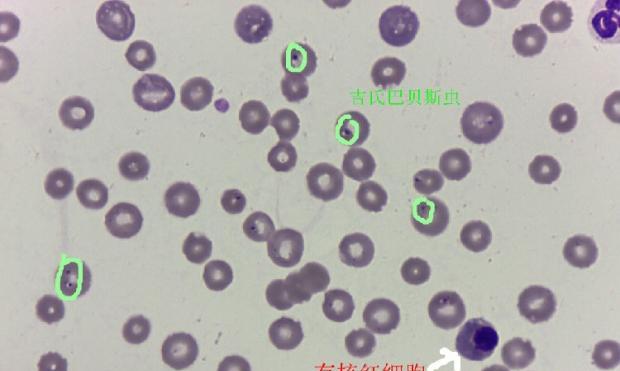Babesia is a protozoan parasitic in red blood cells. Babesia canis can be divided into Babesia canis and Babesia gibseri.
Babesia gizzardii has a small body, also known as Babesia small, with a diameter of about 1-3.3um.
1. Basic pet information:
Pet Name: Rafi.
Pet Breed: Bichon.
Pet Age: Three years old.
Pet Gender: Female (not neutered).
Immunization is complete, deworming is not done.
2. Chief Complaint:
More than ten days ago, the color of urine was dark red and thick, and the mental appetite became poor. At that time, he was checked for severe anemia in another hospital, and the pathological excision operation was performed with pyometra. Now the wound has recovered well, and the mental appetite is still poor.
III. Clinical examination:
Laboratory tests:
Blood routine severe anemia, RBC=1.08, HGB=26, HCT=0.091, extreme anemia.
Blood smear showing red blood cells with parasites

Nucleated erythrocytes and numerous erythrocytes with parasites
Massive reticulocytes seen in blood smear
IV. Treatment:
Symptomatic treatment: blood transfusion, injection of erythropoietin, anti-inflammatory infusion, etc.
Symptomatic treatment: injection of Bernier.
V. Transition:
After half a month of treatment, the pet's condition has improved, the heart rate has recovered, the food, drink, and bowel movements are normal, and he continues to take medicine at home.
| items | Time | Reference value | |||||
| 12th | 14th | 16th | 18th | 20th | 27th | ||
| RBC | 1.08↓ | 1.15↓ | 1.78↓ | 2.64↓ | 2.78↓ | 4.22↓ | 5.5-8.5 |
| HGB | 26↓ | 30↓ | 4.7↓ | 6.7↓ | 6.8↓ | 9.5↓ | 12.0-18.0 |
| HCT | 0.095↓ | 0.12↓ | 17.4↓ | 23.5↓ | 23.8↓ | 32.1↓ | 37.0-55.0 |
| MCH | 24.1↓ | 26.1↑ | 26.4↑ | 25.4↑ | 24.5 | 22.5 | 19.5-25.5 |
| MCHC | 274↓ | 250↓ | 27↓ | 28.5↓ | 28.6↓ | 29.6↓ | 32.0-38.5 |
| MCV | 88↑ | 104.3↑ | 97.8↑ | 89↑ | 85↑ | 76 | 60.0-72.0 |
| PLT | 47↓ | 79↓ | 30↓ | 11↓ | 49↓ | 423 | 200-500 |
| WBC | 15 | 16.4 | 14 | 25↑ | 17 | 22.8↑ | 6.0-17.0 |
| LYM | 2.1 | 3 | 2.4 | 5 | 5.4 | 3 | 0.9-5.0 |
| OTHR | 12 | 10.5 | 11 | 16.3 | 10.4 | 18.1 | 0.3-1.5 |
| EO | 0.9↑ | 2.9↑ | 0.6 | 3.7↑ | 1.2↑ | 1.7↑ | 3.5-12.0 |
Analysis of a case of Babesia canis
Six, extended reading:
The life cycle of Babesia must be completed by two hosts, and the result of the current study is that the tick is the only known terminal host.
1. Schizogene: Babesia enters the body with the saliva of the tick, then parasitizes in the red blood cells, and reproduces in the red blood cells.
2. Gametogenesis: At this stage, sexual reproduction is carried out. Babesia enters the intestine of the tick with the bite of the tick, most of them die, and a small part develops into a radiator (spindle-shaped with flagella protrusions).
3. Sporogenesis: The zygote enters the tick's organ after repeated division and then enters the oocyte of the female tick. After the progeny tick matures and feeds, it enters the salivary gland, and sporulation occurs in the salivary gland.
From the life history of Babesia, we know that it has a great relationship with ticks, so the clinical incidence basically has a history of tick infection.
The incubation period for the disease is 10 to 21 days after exposure to ticks.
The treatment is divided into the cause and the symptomatic treatment. For the treatment of the cause, it is particularly important to correct the symptoms of anemia symptomatically. When the HCT drops to 15% or even lower, blood transfusion should be considered.
